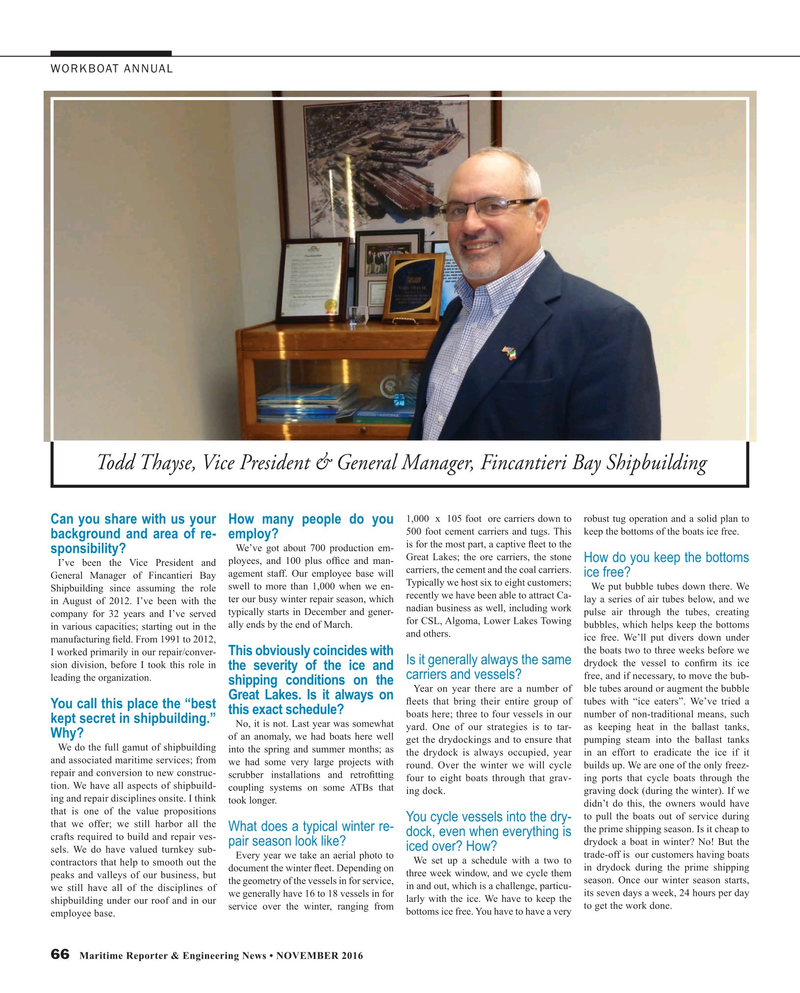
Page 66: of Maritime Reporter Magazine (November 2016)
Workboat Edition
Read this page in Pdf, Flash or Html5 edition of November 2016 Maritime Reporter Magazine
WORKBOAT ANNUAL
Todd Thayse, Vice President & General Manager, Fincantieri Bay Shipbuilding 1,000 x 105 foot ore carriers down to robust tug operation and a solid plan to
Can you share with us your How many people do you 500 foot cement carriers and tugs. This keep the bottoms of the boats ice free.
background and area of re- employ?
is for the most part, a captive ? eet to the
We’ve got about 700 production em- sponsibility?
Great Lakes; the ore carriers, the stone
How do you keep the bottoms
I’ve been the Vice President and ployees, and 100 plus of? ce and man- ice free?
General Manager of Fincantieri Bay agement staff. Our employee base will carriers, the cement and the coal carriers.
Typically we host six to eight customers;
Shipbuilding since assuming the role swell to more than 1,000 when we en- We put bubble tubes down there. We lay a series of air tubes below, and we in August of 2012. I’ve been with the ter our busy winter repair season, which recently we have been able to attract Ca- company for 32 years and I’ve served typically starts in December and gener- nadian business as well, including work pulse air through the tubes, creating in various capacities; starting out in the ally ends by the end of March. for CSL, Algoma, Lower Lakes Towing bubbles, which helps keep the bottoms and others.
ice free. We’ll put divers down under manufacturing ? eld. From 1991 to 2012, the boats two to three weeks before we
I worked primarily in our repair/conver- This obviously coincides with Is it generally always the same drydock the vessel to con? rm its ice sion division, before I took this role in the severity of the ice and carriers and vessels?
free, and if necessary, to move the bub- leading the organization.
shipping conditions on the
Year on year there are a number of ble tubes around or augment the bubble ? eets that bring their entire group of tubes with “ice eaters”. We’ve tried a
You call this place the “best Great Lakes. Is it always on boats here; three to four vessels in our number of non-traditional means, such kept secret in shipbuilding.” this exact schedule?
No, it is not. Last year was somewhat yard. One of our strategies is to tar- as keeping heat in the ballast tanks,
Why?
of an anomaly, we had boats here well get the drydockings and to ensure that pumping steam into the ballast tanks
We do the full gamut of shipbuilding into the spring and summer months; as the drydock is always occupied, year in an effort to eradicate the ice if it and associated maritime services; from we had some very large projects with round. Over the winter we will cycle builds up. We are one of the only freez- repair and conversion to new construc- scrubber installations and retro? tting four to eight boats through that grav- ing ports that cycle boats through the tion. We have all aspects of shipbuild- coupling systems on some ATBs that ing dock. graving dock (during the winter). If we ing and repair disciplines onsite. I think took longer.
didn’t do this, the owners would have that is one of the value propositions to pull the boats out of service during
You cycle vessels into the dry- that we offer; we still harbor all the
What does a typical winter re- dock, even when everything is the prime shipping season. Is it cheap to crafts required to build and repair ves- drydock a boat in winter? No! But the pair season look like?
iced over? How?
sels. We do have valued turnkey sub-
Every year we take an aerial photo to We set up a schedule with a two to trade-off is our customers having boats contractors that help to smooth out the document the winter ? eet. Depending on in drydock during the prime shipping three week window, and we cycle them peaks and valleys of our business, but the geometry of the vessels in for service, season. Once our winter season starts, in and out, which is a challenge, particu- we still have all of the disciplines of we generally have 16 to 18 vessels in for its seven days a week, 24 hours per day larly with the ice. We have to keep the shipbuilding under our roof and in our to get the work done. service over the winter, ranging from bottoms ice free. You have to have a very employee base.
66 Maritime Reporter & Engineering News • NOVEMBER 2016
MR #11 (66-73).indd 66 11/3/2016 8:21:32 PM

 65
65

 67
67
